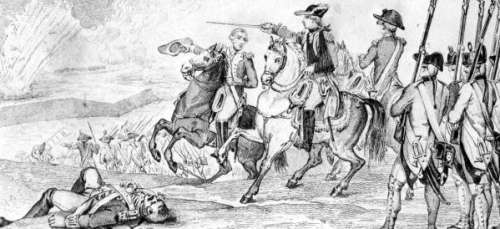 |
Patriot Resource Index
 American Revolution Index
American Revolution Index
 Surveys and Lists
Surveys and Lists
Military Campaigns:
-:Saratoga Campaign
-:Southern Campaign
-:West Florida Campaign:
Part I
Part II
Part III
-:Yorktown Campaign
Reference Lists
Surveys By Year
 American Revolution Index
American Revolution Index
 Battles
Battles
 Documents
Documents
 Events
Events
 Landmarks & Places
Landmarks & Places
 People: The Patriots
People: The Patriots
 People: Continental Army
People: Continental Army
 People: British Army
People: British Army
 Timelines
Timelines
 Books
Books
 Multimedia
Multimedia
 Links & Other Resources
Links & Other Resources
Search the Site
Site Map
Contact Us
PatriotResource.com:
Main Index
Film Index
Film: Gladiator
Film: National Treasure
Film: The Patriot
Film: Tombstone
Films: General
Films: Fantasy
Films: SciFi
History: 1775-1781
History: September 11th
Lord of the Rings
NORAM Road Trips
OtherWorld: Index
TV Series: Index
TV: Battlestar Galactica
TV: Caprica
TV: Deadliest Catch
TV: Lost
TV Series: Action
TV Series: Animated
TV: BBC Presentations
TV Series: Comedy
TV Series: Drama
TV: Fantasy/SciFi
TV Series: Western
TV Series: Reviews
Military Campaigns:
-:Saratoga Campaign
-:Southern Campaign
-:West Florida Campaign:
Part I
Part II
Part III
-:Yorktown Campaign
Reference Lists
Surveys By Year
Site Map
Contact Us
Main Index
Film Index
Film: Gladiator
Film: National Treasure
Film: The Patriot
Film: Tombstone
Films: General
Films: Fantasy
Films: SciFi
History: 1775-1781
History: September 11th
Lord of the Rings
NORAM Road Trips
OtherWorld: Index
TV Series: Index
TV: Battlestar Galactica
TV: Caprica
TV: Deadliest Catch
TV: Lost
TV Series: Action
TV Series: Animated
TV: BBC Presentations
TV Series: Comedy
TV Series: Drama
TV: Fantasy/SciFi
TV Series: Western
TV Series: Reviews

Gálvez had planned ahead yet again and had sent ahead instructions to New Orleans and Mobile that reserves should make for Pensacola. On March 9, Gálvez reached Santa Rosa Island outside Pensacola Bay. On March 11, he attempted to enter the bay after securing the island, but the flagship "San Ramon" ran aground. After she quickly worked free, she returned to her former position outside the bay.
The next few days were spent unloading more supplies onto Santa Rosa Island, while Gálvez tried to convince Captain José Calbo of the "San Ramon" to try again, or allow the smaller ships to go ahead first. Calbo was reluctant and even though Gálvez was in command of the expedition, Calbo was responsible for the safety of the fleet and was within his right to refuse. Gálvez knew he had to enter the bay in order to be successful, so he boarded the brig "Galveztown" on March 18 and led four ships into the bay without consulting with Calbo. The next day Gálvez was able to convince Calbo to send in the rest of the fleet. Calbo himself took the "San Ramon" back to Havana. Gálvez now waited for his forces from New Orleans and Mobile and began correspondence with British General John Campbell in Fort George in Pensacola. On March 22, the forces from New Orleans and Mobile arrived. On March 24, Gálvez moved his men from Santa Rosa Island to the mainland.
On March 25, Indians allied with the British attacked some stragglers. These attacks continued daily and nightly, and even though they were rather small and did little real damage, they raised tension and slowed down the Spanish preparations for the siege. During April, little action took place as the Spanish familiarized themselves with the area. On April 19, a Spanish fleet arrived in support from Havana. On the last three days of April a tunnel was dug from the Spanish line to a small hill where a battery would be erected to attack the British redoubt. On May 1, a battery of six twenty-four pounders was installed. The trenching continued and a stronger battery was installed at Pine Hill, but the British successfully attacked this position, destroying the battery. Artillery fire was exchanged fiercely the next few days.
On May 8, a shot struck the powder magazine of the British redoubt, destroying the position and killing nearly a hundred men. The Spanish quickly moved forward to take possession of the position and began heavy bombardment of Fort George itself. The fort was so exposed to this position that a white flag was run up by 3 o'clock that same afternoon. Formal surrender took place on May 10. Gálvez sent the British prisoners to New York so they could eventually be repatriated. With the capture of Pensacola, the British were expelled from West Florida, making it a Spanish possession, while also ridding the American colonies of a potential southern threat from the British. Gálvez remained governor of Louisiana and West Florida until 1783. In 1783 he returned to Spain for a year. In late 1784, Gálvez returned to Havana, where he found Oliver Pollock had been imprisoned. Gálvez freed Pollock and ordered his property returned to him, and as a further gesture to promote good relations with the newly formed United States, Gálvez released all American sailors who had been imprisoned as smugglers.
Bibliography:
1. Caughey, John; Bernardo De Gálvez in Louisiana: 1776-1783
Picture: Battle of Pensacola Lithograph
Topic Last Updated: 12/6/2000
Available at Amazon.com:

Bernardo de Galvez in Louisiana, 1776-1783
by John Caughey
